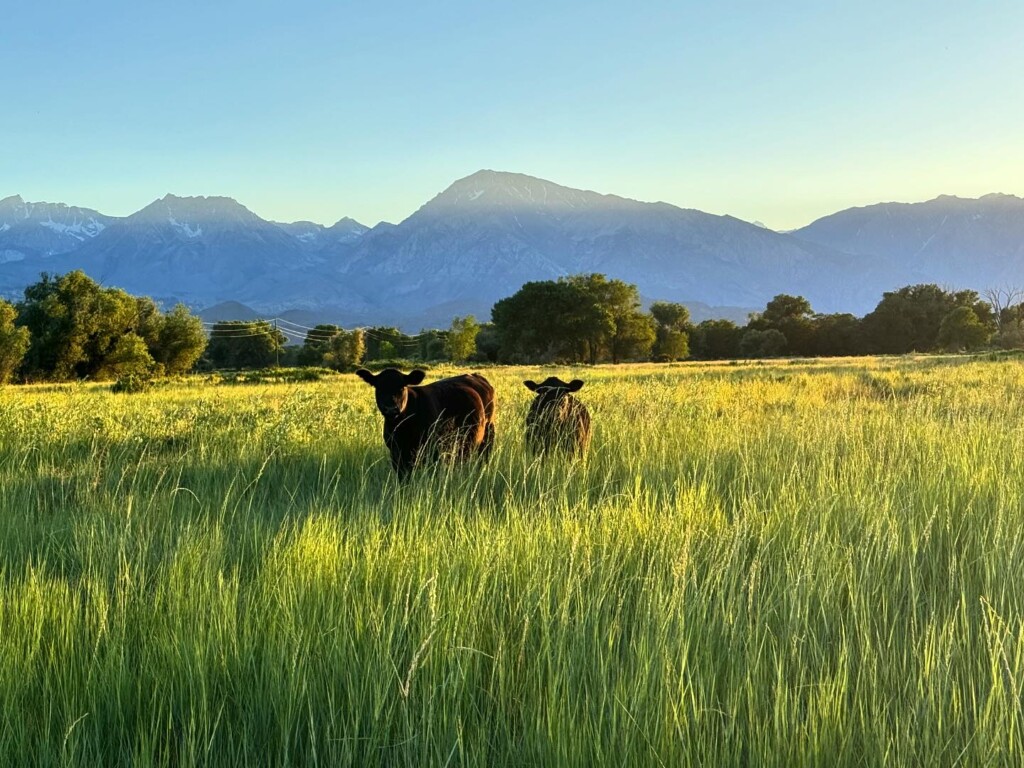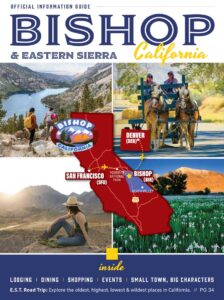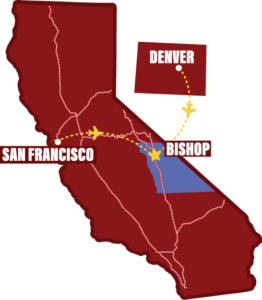Bishop by the Numbers
Bishop is the heart of the Eastern Sierra. This magnificent region of high desert valleys and spectacular mountain ranges has captivated adventurers and explorers for centuries.
Broadly speaking, the Eastern Sierra is a huge region of eastern California that covers an extensive area on the eastern side of the Sierra Nevada mountain range. It is a sparsely populated, high desert region that spreads across two counties, Inyo County and Mono (pronounced moh-no) County. It incorporates only a handful of towns with hundreds of square miles of pristine and publicly accessible terrain. The topography and geography of the region encompasses the deep Owens Valley, the tall and rugged Sierra Nevada to the west, the gentle giants of the White and Inyo mountains to the east, and the magnificent Mono Basin on the northern plateau.
Bishop is right in the middle of this gorgeous, natural, and accessible landscape.
History
Manahüü. Hello.
Welcome to Payahǖǖnadǖ—Place of Flowing Water. Long before explorers, miners, and settlers arrived in the region, this broad, fertile valley and soaring mountains were home to the Nuumu (Paiute) and Newe (Shoshone) people. Today the Bishop Paiute Tribe is a sovereign nation located in the heart of the Eastern Sierra adjacent to Bishop. It is the fifth largest tribe in California with about 2,000 enrolled members.
In late 1845 the first explorers ventured into this region and, with the discovery of gold in California just 3-years later, miners and settlers arrived in increasing numbers. By 1860 the Owens Valley was a thriving farming and mining area. In 1861, Samuel Addison Bishop arrived with his wife, several hired hands, an impressive herd of 600 cattle, and 50 horses to settle in the Owens Valley. They established a homestead, the San Francis Ranch, alongside a creek which still bears his name today—Bishop Creek. Within a year, a few miles east of the ranch, the frontier settlement of Bishop Creek became a town and is today the City of Bishop in Inyo County, California.
Getting Here
U.S. Highway 395 is the main thoroughfare that takes travelers through this beautiful region.
It runs almost the entire length of the western U.S.A. from Hesperia in southern California to the Canadian border for 1,300-miles. It slices through the heart of the Eastern Sierra from Little Lake to Topaz Lake for 235-miles. Bishop sits halfway along this gorgeous route, winding through mountains and stretching across high desert plains, presenting astonishing views and attractions along the way.
Bishop is, give or take, a 4.5-hour drive from Los Angeles and about 3.5-hours from Reno along this scenic route. Equally scenic, the drive from San Francisco is a little longer, 6-hours in summer and possibly 7-hours in winter. Cruising through the expansive Nevada desert the journey from Las Vegas is about 4‑hours. No matter which route you take, it’s a scenic, awe-inspiring journey.
It’s also a short flight to Bishop Airport, the gateway to the Eastern Sierra, offering convenient, daily flights from San Francisco and Denver on a seasonal basis.
Geography & Topography
Spread out along the eastern side of the Sierra Nevada, the Owens Valley is a vast landscape measuring about 100-miles long and between 6- to 18-miles wide. The valley floor sits around 4,000- and 4,500-feet above sea level, flanked by the Sierra Nevada to the west and the White and Inyo mountains to the east. Steep granite peaks rise dramatically on both sides with numerous summits reaching more than 14,000-feet.
Geologists consider the Owens Valley one of the deepest valleys in the United States. Check out this relic from 1984, a geologic guidebook.
This massive change in elevation creates a diverse landscape of deserts and sand dunes, huge mountains and alpine forests, meandering rivers and tumbling waterfalls. The Eastern Sierra has some of the most topographically diverse and beautiful landscapes on the continent.
Climate
For more than 330 days a year Bishop is bathed in sunshine.
In winter the average daily highs are between 50-60 degrees and lows seldom drop much below freezing at night. Summer temperatures hover in the mid- to upper-90s during the day and drop refreshingly to mid-50s at night—typical for a desert environment. Spring produces wildflowers and fall creates a dazzling fall color show—both of which have long color seasons due to the diverse topography of the region.
The average annual rainfall in Bishop is a little under 6-inches and, in winter, an average of 6-inches of snow per year falls in town.
This is all due to the mighty Sierra Nevada that divides California. The range is 400-miles long and along most of its length it’s over 9,000-feet high with over 120 peaks above 13,000-feet. It is the ‘water trap’ for California causing precipitation from the Pacific to fall mainly in the form of snow on its crest. It casts a ‘rain shadow’ over the Owens Valley creating a dry, yet verdant floodplain with a meandering river and rugged foothills, below tall, picturesque snowcapped mountains.
It is one of the most photographed regions in the country.
Demographics
Bishop is the largest town in the Eastern Sierra and is the commercial center of Inyo County.
According to Census 2020, the incorporated City of Bishop has a population of 3,819 people. Greater Bishop, that includes nearby unincorporated neighborhoods and outlying settlements, brings the grand total to 13,075—well over half the entire county.
Inyo County has a total land area of about 10,200-square-miles and a population of 19,016 persons. All but 856 Inyo County residents live in the Owens Valley, which has an area of about 3,330-square-miles. Even so the Owens Valley remains one of the least populated regions in the country with a population density of fractionally more than 5.45 persons per square mile.
Public Lands
Inyo County, the second-largest county in California, and its northern neighbor, Mono County, two of the least populated counties in the state, comprise almost 10% of the total land area of all of California. A staggering 99% of land in Inyo County and 93.6% of Mono County is designated as public land. This adds up to an incredible amount of beautiful and diverse land for adventure and exploration.
The Eastern Sierra, unlike so many other primordial lands of the world, remains relatively untouched by human interference. It is still wild and diverse with massive mountains, deep glacial canyons, wide rift valleys, and clear dark skies. Night sky viewing in the Eastern Sierra is one the best experiences in the world.
We call this our big backyard! It is huge, stunningly beautiful, and easily accessible.
There’s always time for a quick adventure … even a short one!


